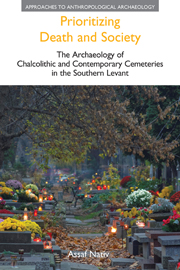 Prioritizing Death and Society
Prioritizing Death and Society from Part I - Introduction
Not to be confused with death, this book is concerned with cemeteries — the elucidation and understanding of Chalcolithic (4500—3700 BCE) and contemporary cemeteries in the Southern Levant. Death is a universal phenomenon that elicits a variety of cultural responses, while cemeteries are but one possible outcome, resulting from the accumulated effect of repeated inhumations in a prescribed location. In Western culture, the two concepts are intimately related; this, however, is by no means always the case and the distinction between them is important to maintain. To focus our attention on cemeteries means to put their structure, organization and dynamics in the centre, while death, whether as concept or experience, is of subsidiary relevance.
This order of priorities is not entirely natural for the Western mind. Death figures large in religion, the arts and the sciences. The social sciences, in particular, and archaeology among them take on a strikingly broad range of related phenomena: grief, near-death experiences, funerary practices, euthanasia, stillbirth, religion, ritual, social structure and relations, gender, kinship, memory and many more. It is singularly ironic, however, that cemeteries, perhaps the most conspicuous expression of death in Western society, rarely figure as objects of study in their own right, but are systematically expropriated in favour of other interests. Any survey of literature pertaining to death and its expressions in the archaeological record will undoubtedly cover an extraordinary diversity of themes, but discussions of cemeteries, their structure and logic are hard to come by.
To save this book to your Kindle, first ensure [email protected] is added to your Approved Personal Document E-mail List under your Personal Document Settings on the Manage Your Content and Devices page of your Amazon account. Then enter the ‘name’ part of your Kindle email address below. Find out more about saving to your Kindle.
Note you can select to save to either the @free.kindle.com or @kindle.com variations. ‘@free.kindle.com’ emails are free but can only be saved to your device when it is connected to wi-fi. ‘@kindle.com’ emails can be delivered even when you are not connected to wi-fi, but note that service fees apply.
Find out more about the Kindle Personal Document Service.
To save content items to your account, please confirm that you agree to abide by our usage policies. If this is the first time you use this feature, you will be asked to authorise Cambridge Core to connect with your account. Find out more about saving content to Dropbox.
To save content items to your account, please confirm that you agree to abide by our usage policies. If this is the first time you use this feature, you will be asked to authorise Cambridge Core to connect with your account. Find out more about saving content to Google Drive.